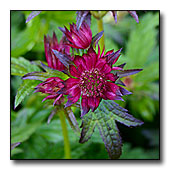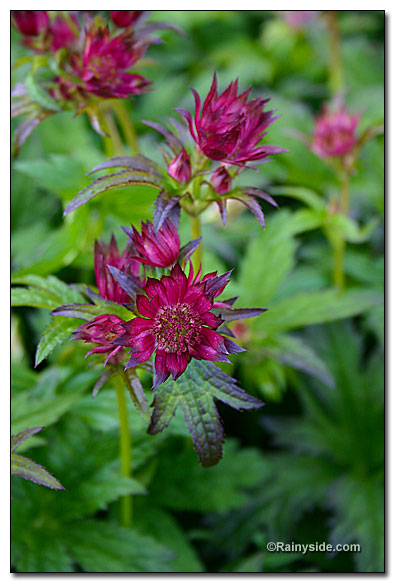Astrantia major 'Hadspen Blood'
MASTORWORT
Family: Apiaceae
Pronounced: as-TRAN-tee-a MAY-jor

Quick Jumps
Growing Guide
Rainy Side Notes
GROWING GUIDE

Geographical origin:
Garden.
Plant group:
Perennial.
Hardiness:
Sunset zones: 1-9, 14-24.
USDA zones: 5-9.
Heat zones: 7-1.
Mature size:
Height: 18 inches (45 cm).
Width: 12 inches (30 cm).
Flowering period:
Spring, with another flush of blooms during summer.
Flowering attributes:
What looks like pointy petals are dark purplish-red bracts holding the tiny red flowers in the center.
Leaf attributes:
Green, deeply lobed leaves.
Growth habit:
Clump-forming.
Light:
Full sun or partial shade.
Soil:
Humus rich, moist, well-drained soil.
Feeding:
Side dress with compost or manure. Fertilize in spring through early summer with a complete organic fertilizer.
Propagation methods:
Every four years, divide in spring.
Pruning methods:
Keep flowers deadheaded for prolonged blooms.
Pests and diseases:
Slugs can be a problem as well as downy mildew.
Rainy Side Notes
Out of Somerset, England came Astrantia major 'Hadspen Blood', selected by Nori and Sandra Pope of Hadspen Garden and Nursery. This perennial, a relative to the carrot, grows best in cool, moist, shaded conditions, similar to astilbe’s needs.
Give it plenty of humus every year and keep the plants well watered. Like astilbe, astrantias will suffer during our summer drought without supplemental watering. It will thrive in optimum growing conditions in partial shade, and spread by runners. In full sun, it will flower more prolifically; however, additional watering is necessary. Divide the plants every four years, after which they will sulk for a while, resenting the disturbance, but soon come around, spreading and blooming and tossing their progeny around.
As with many masterworts, this cultivar is a prolific seeder. If you let it seed around, you will wind up with a variety of colors. After first flush of blooms, cut stalks all the way to the ground. This will help take care of the seeding, and give you another flush of blooms during the summer. Faithfully keep the plants deadheaded and they will keep continue to give you flowers into September.
Astrantias are fantastic both as cut flowers for the vase and dried flowers. For best results harvest when the top ones open up. Any sooner and the flowers wilt, and cut later they won’t hold up long in the vase. When harvesting, cut blooms all the way back to the base foliage. Flowers will last up to two weeks in the vase.
Photographed in Terra Nova Nursery's garden.

Gardening for the Homebrewer: Grow and Process Plants for Making Beer, Wine, Gruit, Cider, Perry, and More
By co-authors Debbie Teashon (Rainy Side Gardeners) and Wendy Tweton
Copyright Notice | Home | Search | Perennials

